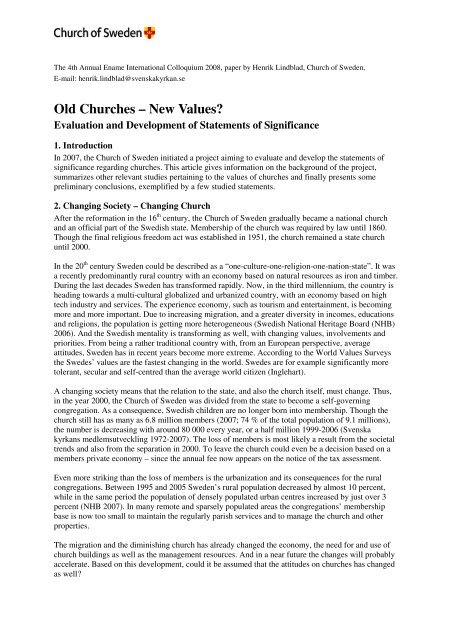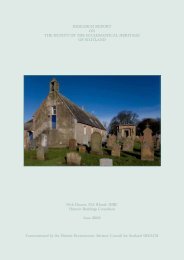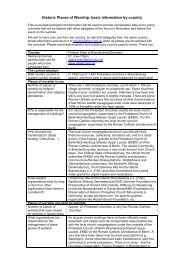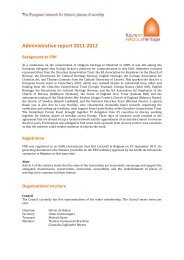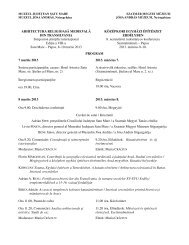Old Churches â New Values? - Future for Religious Heritage (FRH)
Old Churches â New Values? - Future for Religious Heritage (FRH)
Old Churches â New Values? - Future for Religious Heritage (FRH)
Create successful ePaper yourself
Turn your PDF publications into a flip-book with our unique Google optimized e-Paper software.
The 4th Annual Ename International Colloquium 2008, paper by Henrik Lindblad, Church of Sweden,<br />
E-mail: henrik.lindblad@svenskakyrkan.se<br />
<strong>Old</strong> <strong>Churches</strong> – <strong>New</strong> <strong>Values</strong>?<br />
Evaluation and Development of Statements of Significance<br />
1. Introduction<br />
In 2007, the Church of Sweden initiated a project aiming to evaluate and develop the statements of<br />
significance regarding churches. This article gives in<strong>for</strong>mation on the background of the project,<br />
summarizes other relevant studies pertaining to the values of churches and finally presents some<br />
preliminary conclusions, exemplified by a few studied statements.<br />
2. Changing Society – Changing Church<br />
After the re<strong>for</strong>mation in the 16 th century, the Church of Sweden gradually became a national church<br />
and an official part of the Swedish state. Membership of the church was required by law until 1860.<br />
Though the final religious freedom act was established in 1951, the church remained a state church<br />
until 2000.<br />
In the 20 th century Sweden could be described as a “one-culture-one-religion-one-nation-state”. It was<br />
a recently predominantly rural country with an economy based on natural resources as iron and timber.<br />
During the last decades Sweden has trans<strong>for</strong>med rapidly. Now, in the third millennium, the country is<br />
heading towards a multi-cultural globalized and urbanized country, with an economy based on high<br />
tech industry and services. The experience economy, such as tourism and entertainment, is becoming<br />
more and more important. Due to increasing migration, and a greater diversity in incomes, educations<br />
and religions, the population is getting more heterogeneous (Swedish National <strong>Heritage</strong> Board (NHB)<br />
2006). And the Swedish mentality is trans<strong>for</strong>ming as well, with changing values, involvements and<br />
priorities. From being a rather traditional country with, from an European perspective, average<br />
attitudes, Sweden has in recent years become more extreme. According to the World <strong>Values</strong> Surveys<br />
the Swedes’ values are the fastest changing in the world. Swedes are <strong>for</strong> example significantly more<br />
tolerant, secular and self-centred than the average world citizen (Inglehart).<br />
A changing society means that the relation to the state, and also the church itself, must change. Thus,<br />
in the year 2000, the Church of Sweden was divided from the state to become a self-governing<br />
congregation. As a consequence, Swedish children are no longer born into membership. Though the<br />
church still has as many as 6.8 million members (2007; 74 % of the total population of 9.1 millions),<br />
the number is decreasing with around 80 000 every year, or a half million 1999-2006 (Svenska<br />
kyrkans medlemsutveckling 1972-2007). The loss of members is most likely a result from the societal<br />
trends and also from the separation in 2000. To leave the church could even be a decision based on a<br />
members private economy – since the annual fee now appears on the notice of the tax assessment.<br />
Even more striking than the loss of members is the urbanization and its consequences <strong>for</strong> the rural<br />
congregations. Between 1995 and 2005 Sweden’s rural population decreased by almost 10 percent,<br />
while in the same period the population of densely populated urban centres increased by just over 3<br />
percent (NHB 2007). In many remote and sparsely populated areas the congregations’ membership<br />
base is now too small to maintain the regularly parish services and to manage the church and other<br />
properties.<br />
The migration and the diminishing church has already changed the economy, the need <strong>for</strong> and use of<br />
church buildings as well as the management resources. And in a near future the changes will probably<br />
accelerate. Based on this development, could it be assumed that the attitudes on churches has changed<br />
as well?
3. Citizen Inquiry<br />
The Church of Sweden has recently made a national inquiry, interviewing 4 000 randomly<br />
selected citizens, church members as well as non-members (see summary in Svenska kyrkans<br />
redovisning för år 2007). The results, considering the mentioned societal trends, are interesting:<br />
• Over 80 % agreed that churches symbolize important events in life<br />
• 70 % believed that church buildings represent cultural values<br />
• 77 % of members and 70 % of non-members objected to demolishing churches<br />
• A large majority agreed that “a church is a church”; it can be used <strong>for</strong> religious, cultural and<br />
social events (but not as dwellings, shops or restaurants) and should be preserved<br />
The World <strong>Values</strong> Survey has indicated that Swedes have the most modern values in the world.<br />
However, concerning attitudes on religious heritage, Swedes can be seen as rather conservative. This<br />
could be taken <strong>for</strong> a counter-trend in the development. But it probably also shows the importance of<br />
traditional heritage and its values in a society that is changing very fast. Another reason <strong>for</strong> these<br />
attitudes could be that the church was a part of the state <strong>for</strong> many centuries and there<strong>for</strong>e considered a<br />
common heritage and property. The importance of churches as public centres in vast and sparsely<br />
populated areas should also be considered.<br />
4. Protection and Grants<br />
There is still a broad political will to preserve the religious heritage. The approx. 3 000 Swedish<br />
churches built be<strong>for</strong>e 1940, ecclesiastical inventories and burial places, are protected by the <strong>Heritage</strong><br />
Conservation Act (HCA). According to the act they are to be preserved and cared <strong>for</strong> in order to<br />
maintain their cultural values. Any changes require special permission from the County<br />
Administrative Board.<br />
According to the first paragraph in the HCA; “The historical cultural values inherent in church<br />
buildings, church sites, ecclesiastical furnishings and cemeteries are protected…”. And further on;<br />
“Church buildings and church sites shall be cared <strong>for</strong> and maintained in such a way that their cultural<br />
historic value is not diminished and their appearance and character are not debased.” However, what is<br />
to be regarded as cultural historic values are not defined in the act. That these values are tangible and<br />
based on the fabric are usually taken <strong>for</strong> granted by the experts.<br />
The 2000 separation of church and state resulted in an economic agreement between the Church and<br />
the state. The Church is, to cover the extra costs of restorations and conservations designed to comply<br />
with the HCA, entitled to a yearly state grant. The sum of the grant has according to the plan increased<br />
every year to a maximum of 465 million kronor (49 million Euros) in 2009. The year 2009 is also the<br />
last year of the agreement and the effects and the sum of the grants are now to be evaluated and<br />
reconsidered by the government.<br />
5. Conservation Management Plans<br />
To receive state grants, the parishes must provide a conservation and management plan. The first plans<br />
were made in 2002. In May 2008 there were 2625 complete plans. Every plan includes a statement of<br />
significance, which the management goals and conservation decisions should be based on. The<br />
statements are important tools <strong>for</strong> allocation of state grants, as well as <strong>for</strong> judgments of changes in<br />
churches. The congregation, or a larger administrative unit often managing several churches, is<br />
responsible <strong>for</strong> producing and implementing the plan, generally under supervision by the diocese. The<br />
plan is usually coordinated by a contractor, while the county museum, or more rarely a private heritage<br />
consultant, is per<strong>for</strong>ming the section on cultural history and significance.<br />
A method <strong>for</strong> identifying cultural heritage values in churches was developed by the NHB, in<br />
collaboration with the regional heritage sector, and published in the 2002 handbook Cultural Historic<br />
Characterisation and Assessment of <strong>Churches</strong> (Kulturhistorisk karaktärisering och bedömning av<br />
kyrkor. Since it was developed <strong>for</strong> the protected churches, the characterisation method is not supposed
to identify the general values of the churches, but to assess the specific (predominantly material)<br />
elements characterising the individual church. This method (I) has been used widely in most dioceses<br />
(see below). However, another already established method, also developed by the NHB, was published<br />
the same year in the book; Cultural Historic Valuation of Buildings (Kulturhistorisk värdering av<br />
bebyggelse). The referred method (II), though like the <strong>for</strong>mer principally expert oriented, is relatively<br />
broad. It includes <strong>for</strong> example aesthetic or “experience” values and could be applied on all built<br />
heritage. The consequence is that some consultants have applied method II instead of I, and many<br />
heritage officers have used a combination of both methods (below).<br />
6. The Management Plan Study 2005<br />
Three years ago the Church commissioned a nationwide evaluation on the management plans made<br />
between 2002 and 2005. The study, per<strong>for</strong>med by the NHB, focused on a sample of 44 management<br />
plans including statements of significance. The outcome of the brief analysis of the statements is of<br />
importance to the present study.<br />
The 2005 study indicated that few of the plans were based on the statements of significance. They<br />
were entirely expert generated (often made by regional conservation officers) not sufficiently<br />
integrated in the plans (generally per<strong>for</strong>med by other contractors) and focused on the church buildings,<br />
ecclesiastical artefacts and related tangible values. Local use, traditional beliefs and intangible values<br />
were typically not considered. The parish and other local stakeholders were sometimes consulted, but<br />
rarely involved in the assessments and sometimes not even in the overall planning process.<br />
The focus on the fabric and the tangible values is in part caused by the <strong>for</strong>mulation of the more than 20<br />
year old cultural heritage act (above). The statements are generally per<strong>for</strong>med by one, or sometimes a<br />
group of professionals; art historians, architects or conservators, from the county museum, the county<br />
administrative board and the diocese. Since they are all trained in identifying tangible values, the<br />
material focus is emphasized.<br />
7. Evaluation and Development of Statements of Significance<br />
From 2002 and onwards approx. 2600 statements of significance of churches have been produced<br />
nationwide. The main objectives of this new evaluation project are to:<br />
• Study the content and how statements are created and applied<br />
• Analyse and conclude identified national, regional and local values<br />
• Develop methods <strong>for</strong> including more stakeholders and increasing local participation in<br />
assessing and managing values<br />
• Update the method <strong>for</strong> statements of significance into a modern and more inclusive model<br />
• Develop a system <strong>for</strong> priority setting of values on local, regional and national levels; <strong>for</strong><br />
allocation of grants and decisions on <strong>for</strong> example changed use of churches<br />
The project is managed by the Central Church Office and carried out in collaboration with the dioceses<br />
and the county museums in Göteborg, Karlstad, Skara and Linköping, which now are concluding the<br />
statements of significance made in their dioceses. Connected to the project is a “reference network”<br />
including heritage experts, property managers and researchers from <strong>for</strong> example the National <strong>Heritage</strong><br />
Board, The National Property Board, universities, county museums and the church. One goal of the<br />
network was to organize and attend a workshop on theory and practice in heritage valuation,<br />
per<strong>for</strong>med in June 3, 2008 with 25 participants. Preceding this conference was also a “pilot workshop”<br />
in April 2008 with the heritage officers in the 13 Swedish dioceses.<br />
8. Preliminary Results<br />
The next phase of the project will be an analysis of the workshops per<strong>for</strong>med in April and June 2008,<br />
as well as completing a report on the studied statements. However, the analysis of the statements and<br />
the discussions during the workshops have resulted in a relative consensus. The project groups and<br />
reference network have largely agreed on the importance of broadening and improving the statements,<br />
identifying and including more stakeholders in the valuation process and integrating the statements in
the management plans (on management planning and valuing processes, see Mason 2002, 2006 and<br />
Turnpenny 2004). Following are some basic facts and preliminary results:<br />
• In May 2008 there were 2625 completed statements of significance nationwide<br />
• Eleven dioceses (out of 13) have produced statements of significance using the<br />
characterisation method (I), or a combination of method I and II (Cultural Historic Valuation<br />
of Buildings)<br />
• The diocese of Lund is applying method II only. The statements are per<strong>for</strong>med by<br />
conservation officers from several different (private) contractors and are of a more differing<br />
quality compared to the statements in other dioceses. They are, however, more integrated in<br />
the management plans since they generally are made simultaneously and by the same<br />
contractor.<br />
• The small diocese of Visby, consisting of 92 well preserved medieval churches, has, regarding<br />
their churches presumed high values, decided to not produce any statements <strong>for</strong> their<br />
management plans<br />
• Half of the dioceses have made their statements accessible in the NHB’s built heritage<br />
database. Since the remaining statements are not available from any national database the<br />
general accessibility is low.<br />
• Four dioceses (Göteborg, Karlstad Skara and Linköping) are compiling their own reports or<br />
conclusions which will support the national project’s work<br />
• In some dioceses have a number of museums, or other consultants, defined the churches’ level<br />
of significance using the terms “Important at national, regional or local levels”. Since this is<br />
not consistently done and the criteria <strong>for</strong> defining the levels are vague or differing, it is<br />
virtually impossible to get a national picture of the churches’ values.<br />
• The per<strong>for</strong>mance, quality and usability differs according to the orderer’s (the diocese or the<br />
parish) and contractor’s ambition and competence. There are some statements of high quality,<br />
though many are either too descriptive or too subjective.<br />
• A preliminary conclusion of the project, based on results of the study and the workshops, is<br />
that the following prerequisites need to be fulfilled to get a functional statement of good<br />
quality:<br />
- A consistent and well structured valuation model and terminology<br />
- A distinct assignment from the property manager (diocese and/or parish)<br />
- Experienced contractors (museums or private consultants) with sufficient overview of<br />
regional and national church values<br />
- Stakeholders identified and included in the valuation process, which should regard<br />
diverse groups, values and priorities<br />
- A broad and simultaneously specific statement with more focus on intangible values<br />
and with more distinct conclusions<br />
- Statements should be integrated in the management plan<br />
- Statements should be quality assured (<strong>for</strong> example through peer review), regularly<br />
evaluated and updated (<strong>for</strong> example every five or ten years)
9. Case Studies – Examples<br />
Frösö Church<br />
The Swedish composer Wilhelm Peterson-Berger had his second home by a medieval church on the<br />
island of Frösö in north-western Sweden. Around 1900 he composed several very popular nationalromantic<br />
tunes inspired by this impressive Nordic natural and cultural landscape. The composer was<br />
finally buried on the cemetery by the church. The statement of significance, per<strong>for</strong>med by the regional<br />
museum, mentions Wilhelm Peterson-Berger, but the composer’s and his music’s connection with the<br />
church is not considered a national value, or a value at all, since the statement is entirely focused on<br />
the architecture of the church.<br />
This intangible value could be connected to several other values, related to nature, recreation and<br />
learning. In presenting such values, immigrants and visitors from other cultures and religious<br />
backgrounds, would get a deeper understanding of recent Swedish history and mentality – where<br />
natural values often still are considered more important than cultural values.<br />
Fig. 1. Frösö Church in the Nordic landscape. Photo: Pål-Nils Nilsson.<br />
Examples of intangible values not identified in the statement:<br />
- National identity (& history of)<br />
- Symbol (regional, national, international symbol of Sweden)<br />
- Music (national composer)<br />
- Spiritual (<strong>for</strong> example in nature)<br />
Examples of use/other values not identified:<br />
- Nature (ecosystem, recreation)<br />
- Social (non-religious)<br />
- Experience/tourism/local economy<br />
- Learning (new groups, cultures, religions)
Gustav Vasa Church<br />
In 1958 the Church Assembly took the historic decision that women could become priests in the<br />
Church of Sweden. In 2008 the 50 th anniversary is nationally celebrated.<br />
However, as can be seen on the front page of the leading Swedish newspaper Dagens Nyheter, already<br />
in 1911 the American Methodist minister Anna Shaw preached in Gustav Vasa church in central<br />
Stockholm in front of several hundreds of spectators.<br />
Fig. 2. Anna Shaw preaching in Gustav Vasa Church. Dagens Nyheter,<br />
June 12, 1911.<br />
This is the first known female sermon in Sweden, and a milestone in the Swedish history of women’s<br />
liberation and voting rights. This story is not told in the history of this particular church and a good<br />
example of an intangible value that should be identified and acclaimed.
Dalby Church<br />
The statement of Dalby church in northern Värmland, built 1928 as the fourth church on this site, is<br />
entirely focused on the architecture of the building. This beautiful and well preserved church, in a<br />
stunning <strong>for</strong>est setting, is indeed of regional and maybe even of national value – especially <strong>for</strong> art<br />
historians and architects – but local and intangible values are not identified.<br />
It is <strong>for</strong> example not mentioned that the church is situated by the medieval pilgrim way to Nidaros in<br />
Norway (St Olav’s grave in Trondheim Cathedral). In recent years the route has been restored and is<br />
now a regionally, nationally and even internationally popular walking trail (Nilsson 2007). The act of<br />
walking the trail, the trail itself and its context and values associated with this should be considered as<br />
important intangible and tangible values related to the church.<br />
Fig 3. On the Pilgrim Route, Dalby Church,<br />
Northern Värmland. Photo: Peter Nilsson.<br />
Identified values:<br />
• The fourth church on this site; a masterpiece in wood from 1928<br />
• Regional/national architectural values<br />
Other values not mentioned in the statement:<br />
• On the pilgrim route to Nidaros:<br />
- Place history - local identity<br />
- Community/social significance<br />
- Spiritual experience/significance<br />
- Nature (recreation)<br />
- Nature (ecosystem)<br />
- Economy (local trade, service)
References<br />
Inglehart, Ronald. Inglehart-Welzel Cultural Map of the World. World <strong>Values</strong> Survey. Internet.<br />
Available from http://www.worldvaluessurvey.org/; accessed 29 July 2008.<br />
Inglehart, Ronald. Collection of Graphs Presenting WVS Data. World <strong>Values</strong> Survey. Internet.<br />
Available from http://www.worldvaluessurvey.org/; accessed 29 July 2008.<br />
Mason Randall. 2006. Theoretical and Practical Arguments <strong>for</strong> <strong>Values</strong>-Centred Preservation. CRM:<br />
The Journal of <strong>Heritage</strong> Stewardship, Volume 3 Number 2 Summer.<br />
Mason, Randall. 2002. Assessing <strong>Values</strong> in Conservation Planning: Methodological Issues and<br />
Choices. Assessing the <strong>Values</strong> of Cultural <strong>Heritage</strong>. Research Report. The Getty Conservation<br />
Institute, Los Angeles.<br />
Nilsson, Peter. 2007. Pilgrimsvandring med en extra knorr. Nya Wermlandstidningen July 2.<br />
Schwanborg, Ingrid. 2002. Kulturhistorisk karaktärisering och bedömning av kyrkor (Cultural<br />
Historic Characterisation and Assessment of <strong>Churches</strong>). Riksantikvarieämbetet.<br />
Svenska kyrkans medlemsutveckling år 1972-2006, Kyrkan i siffror. Internet. Available from<br />
http://www.svenskakyrkan.se/default.aspx?di=23758&refdi=23673; accessed 29 July 2008.<br />
Svenska kyrkans redovisning för år 2007 angående de kyrkliga kulturvärdena och användningen av<br />
den kyrkoantikvariska ersättningen. 27 mars 2008. Dnr: KAE 2008/0005.<br />
The Swedish National <strong>Heritage</strong> Board. 2006. Towards <strong>Future</strong> <strong>Heritage</strong> Management. Environmental<br />
Scanning Report 2006.<br />
The Swedish National <strong>Heritage</strong> Board. 2007. Knowledge through partnership. Environmental<br />
Scanning Report 2007.<br />
Riksantikvarieämbetet, Antikvarisk-tekniska avdelningen. 2005. Utvärdering av vård- och<br />
underhållsplaner. Rapport på uppdrag av Svenska Kyrkan, Kyrkokansliet.<br />
Turnpenny, Michael. 2004. 'Cultural <strong>Heritage</strong>, an Ill-defined Concept? A Call <strong>for</strong> Joined-up Policy'.<br />
International Journal of <strong>Heritage</strong> Studies, 10:3, 295 – 307.<br />
Unnerbäck, Axel R. 2002. Kulturhistorisk värdering av bebyggelse (Cultural Historic Valuation of<br />
Buildings). Riksantikvarieämbetet.


